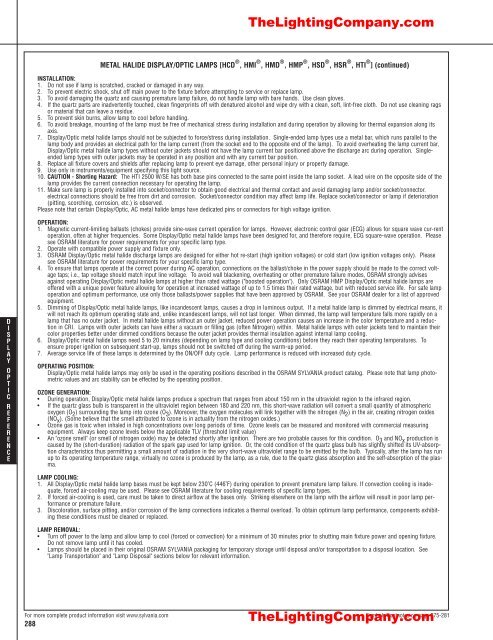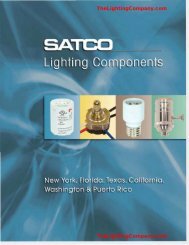Lamp and Ballast Catalog - The Lighting Company
Lamp and Ballast Catalog - The Lighting Company
Lamp and Ballast Catalog - The Lighting Company
- No tags were found...
Create successful ePaper yourself
Turn your PDF publications into a flip-book with our unique Google optimized e-Paper software.
<strong>The</strong><strong>Lighting</strong><strong>Company</strong>.com<br />
METAL HALIDE DISPLAY/OPTIC LAMPS [HCD ® , HMI ® , HMD ® , HMP ® , HSD ® , HSR ® , HTI ® ] (continued)<br />
INSTALLATION:<br />
1. Do not use if lamp is scratched, cracked or damaged in any way.<br />
2. To prevent electric shock, shut off main power to the fixture before attempting to service or replace lamp.<br />
3. To avoid damaging the quartz <strong>and</strong> causing premature lamp failure, do not h<strong>and</strong>le lamp with bare h<strong>and</strong>s. Use clean gloves.<br />
4. If the quartz parts are inadvertently touched, clean fingerprints off with denatured alcohol <strong>and</strong> wipe dry with a clean, soft, lint-free cloth. Do not use cleaning rags<br />
or material that can leave a residue.<br />
5. To prevent skin burns, allow lamp to cool before h<strong>and</strong>ling.<br />
6. To avoid breakage, mounting of the lamp must be free of mechanical stress during installation <strong>and</strong> during operation by allowing for thermal expansion along its<br />
axis.<br />
7. Display/Optic metal halide lamps should not be subjected to force/stress during installation. Single-ended lamp types use a metal bar, which runs parallel to the<br />
lamp body <strong>and</strong> provides an electrical path for the lamp current (from the socket end to the opposite end of the lamp). To avoid overheating the lamp current bar,<br />
Display/Optic metal halide lamp types without outer jackets should not have the lamp current bar positioned above the discharge arc during operation. Singleended<br />
lamp types with outer jackets may be operated in any position <strong>and</strong> with any current bar position.<br />
8. Replace all fixture covers <strong>and</strong> shields after replacing lamp to prevent eye damage, other personal injury or property damage.<br />
9. Use only in instruments/equipment specifying this light source.<br />
10. CAUTION - Shorting Hazard: <strong>The</strong> HTI 2500 W/SE has both base pins connected to the same point inside the lamp socket. A lead wire on the opposite side of the<br />
lamp provides the current connection necessary for operating the lamp.<br />
11. Make sure lamp is properly installed into socket/connector to obtain good electrical <strong>and</strong> thermal contact <strong>and</strong> avoid damaging lamp <strong>and</strong>/or socket/connector.<br />
electrical connections should be free from dirt <strong>and</strong> corrosion. Socket/connector condition may affect lamp life. Replace socket/connector or lamp if deterioration<br />
(pitting, scorching, corrosion, etc.) is observed.<br />
Please note that certain Display/Optic, AC metal halide lamps have dedicated pins or connectors for high voltage ignition.<br />
OPERATION:<br />
1. Magnetic current-limiting ballasts (chokes) provide sine-wave current operation for lamps. However, electronic control gear (ECG) allows for square wave cur-rent<br />
operation, often at higher frequencies. Some Display/Optic metal halide lamps have been designed for, <strong>and</strong> therefore require, ECG square-wave operation. Please<br />
see OSRAM literature for power requirements for your specific lamp type.<br />
2. Operate with compatible power supply <strong>and</strong> fixture only.<br />
3. OSRAM Display/Optic metal halide discharge lamps are designed for either hot re-start (high ignition voltages) or cold start (low ignition voltages only). Please<br />
see OSRAM literature for power requirements for your specific lamp type.<br />
4. To ensure that lamps operate at the correct power during AC operation, connections on the ballast/choke in the power supply should be made to the correct voltage<br />
taps; i.e., tap voltage should match input line voltage. To avoid wall blackening, overheating or other premature failure modes, OSRAM strongly advises<br />
against operating Display/Optic metal halide lamps at higher than rated wattage ("boosted operation"). Only OSRAM HMP Display/Optic metal halide lamps are<br />
offered with a unique power feature allowing for operation at increased wattage of up to 1.5 times their rated wattage, but with reduced service life. For safe lamp<br />
operation <strong>and</strong> optimum performance, use only those ballasts/power supplies that have been approved by OSRAM. See your OSRAM dealer for a list of approved<br />
equipment.<br />
5. Dimming of Display/Optic metal halide lamps, like inc<strong>and</strong>escent lamps, causes a drop in luminous output. If a metal halide lamp is dimmed by electrical means, it<br />
will not reach its optimum operating state <strong>and</strong>, unlike inc<strong>and</strong>escent lamps, will not last longer. When dimmed, the lamp wall temperature falls more rapidly on a<br />
lamp that has no outer jacket. In metal halide lamps without an outer jacket, reduced power operation causes an increase in the color temperature <strong>and</strong> a reduction<br />
in CRI. <strong>Lamp</strong>s with outer jackets can have either a vacuum or filling gas (often Nitrogen) within. Metal halide lamps with outer jackets tend to maintain their<br />
color properties better under dimmed conditions because the outer jacket provides thermal insulation against internal lamp cooling.<br />
6. Display/Optic metal halide lamps need 5 to 20 minutes (depending on lamp type <strong>and</strong> cooling conditions) before they reach their operating temperatures. To<br />
ensure proper ignition on subsequent start-up, lamps should not be switched off during the warm-up period.<br />
7. Average service life of these lamps is determined by the ON/OFF duty cycle. <strong>Lamp</strong> performance is reduced with increased duty cycle.<br />
D<br />
ISPLAY<br />
O<br />
PTIC<br />
R<br />
EFERENCE<br />
For more complete product information visit www.sylvania.com Symbols/Footnotes on page 275-281<br />
OPERATING POSITION:<br />
Display/Optic metal halide lamps may only be used in the operating positions described in the OSRAM SYLVANIA product catalog. Please note that lamp photometric<br />
values <strong>and</strong> arc stability can be effected by the operating position.<br />
OZONE GENERATION:<br />
• During operation, Display/Optic metal halide lamps produce a spectrum that ranges from about 150 nm in the ultraviolet region to the infrared region.<br />
• If the quartz glass bulb is transparent in the ultraviolet region between 180 <strong>and</strong> 220 nm, this short-wave radiation will convert a small quantity of atmospheric<br />
oxygen (O 2 ) surrounding the lamp into ozone (O 3 ). Moreover, the oxygen molecules will link together with the nitrogen (N 2 ) in the air, creating nitrogen oxides<br />
(NO x ). (Some believe that the smell attributed to ozone is in actuality from the nitrogen oxides.)<br />
• Ozone gas is toxic when inhaled in high concentrations over long periods of time. Ozone levels can be measured <strong>and</strong> monitored with commercial measuring<br />
equipment. Always keep ozone levels below the applicable TLV (threshold limit value)<br />
• An "ozone smell" (or smell of nitrogen oxide) may be detected shortly after ignition. <strong>The</strong>re are two probable causes for this condition. O 3 <strong>and</strong> NO x production is<br />
caused by the (short-duration) radiation of the spark gap used for lamp ignition. Or, the cold condition of the quartz glass bulb has slightly shifted its UV-absorption<br />
characteristics thus permitting a small amount of radiation in the very short-wave ultraviolet range to be emitted by the bulb. Typically, after the lamp has run<br />
up to its operating temperature range, virtually no ozone is produced by the lamp, as a rule, due to the quartz glass absorption <strong>and</strong> the self-absorption of the plasma.<br />
LAMP COOLING:<br />
1. All Display/Optic metal halide lamp bases must be kept below 230˚C (446˚F) during operation to prevent premature lamp failure. If convection cooling is inadequate,<br />
forced air-cooling may be used. Please see OSRAM literature for cooling requirements of specific lamp types.<br />
2. If forced air-cooling is used, care must be taken to direct airflow at the bases only. Striking elsewhere on the lamp with the airflow will result in poor lamp performance<br />
or premature failure.<br />
3. Discoloration, surface pitting, <strong>and</strong>/or corrosion of the lamp connections indicates a thermal overload. To obtain optimum lamp performance, components exhibiting<br />
these conditions must be cleaned or replaced.<br />
LAMP REMOVAL:<br />
• Turn off power to the lamp <strong>and</strong> allow lamp to cool (forced or convection) for a minimum of 30 minutes prior to shutting main fixture power <strong>and</strong> opening fixture.<br />
Do not remove lamp until it has cooled.<br />
• <strong>Lamp</strong>s should be placed in their original OSRAM SYLVANIA packaging for temporary storage until disposal <strong>and</strong>/or transportation to a disposal location. See<br />
"<strong>Lamp</strong> Transportation" <strong>and</strong> "<strong>Lamp</strong> Disposal" sections below for relevant information.<br />
288<br />
<strong>The</strong><strong>Lighting</strong><strong>Company</strong>.com




